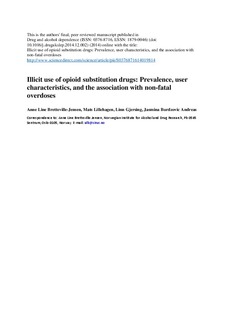Illicit use of opioid substitution drugs: Prevalence, user characteristics, and the association with non-fatal overdoses
Abstract
Diversion of opioid substitution drugs (OSD) is of public concern. This study examined the prevalence, frequency, and predictors of illicit OSD use in a group of injecting drug users (IDUs) and assessed if such use was associated with non-fatal overdoses.Semi-annual cross-sectional interviews conducted in Oslo, Norway (2006–2013), from 1355 street-recruited IDUs. Hurdle, logistic, and multinomial regression models were employed.Overall, 27% reported illicit OSD use in the past four weeks; 16.8% methadone, 12.5% buprenorphine, and 2.9% both drugs. Almost 1/10 reported at least one non-fatal overdose in the past four weeks, and roughly 1/3 reported such experience in the past year. Use of additional drugs tended to be equally, or more prevalent among illicit OSD users than other IDUs. In terms of illicit OSD use being a risk factor for non-lethal overdoses, our results showed significant associations only for infrequent buprenorphine use (using once or less than once per week). Other factors associated with non-fatal overdoses included age, education, homelessness, as well as the benzodiazepines, stimulants, and heroin use.Users of diverted OSD may represent a high-risk population, as they used more additional drugs and used them more frequently than other IDUs. However, illicit OSD use may be less harmful than previously assumed. After accounting for an extensive set of covariates, only infrequent illicit buprenorphine use, but not methadone use, was associated with non-fatal overdoses.
Description
-
